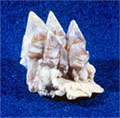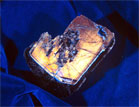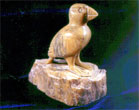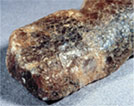The following collection of industrial mineral specimens were photographed as a project of the Mining Week Committee. They depict the quality of collectible mineral specimens available in Newfoundland. All photographs by James Butler. The small images are linked to full sized photographs with more detail, but will take some time to load.
Barite
Barite (BaSO4) is a white, heavy mineral and the main ore of barium. It is used in drilling muds, paints, chemicals and TV screens. The photograph shows platy crystals of barite collected in the Colliers Point area, Isthmus of Avalon, by Art King, MUN Collection 0521.
Barite is the most common barium mineral and is generally a waste-mineral in metalliferous deposits, as at Buchans. Occasionally it forms the major constituent of the vein, as at St. Brides, St. Mary’s Bay, and Colliers Point, Trinity Bay, NF.
Calcite
Calcite is a calcium carbonate (CaCO3) that is the major constituent of limestone. Crystals may be used for their optical properties, particularly in the construction of polarizing prisms.
This sample of calcite, with well-formed crystals, is owned by Dave Evans of the Geological Survey.
Coal
Coal is a general name for a naturally occurring, commonly stratified, rocklike, black or brown derivative of vegetation which has increased its carbon content by burial and compression. It is a fossil fuel. This sample of coal is from one of three areas in western Newfoundland and is the property of the Geological Survey, Newfoundland Dept. of Mines and Energy.
Coal is first mentioned in early reports by Captain James Cook (1765) who conducted systematic surveys of the Newfoundland coast, although it was probably known to aboriginal residents much earlier. It occurs in three areas in Newfoundland: in the Codroy Valley, near Grand Lake and around St. George’s Bay. Although explored and used for a time to fuel the Newfoundland Railway’s steam engines at the turn of the last century, economic deposits have yet to be discovered.
Fluorite
Fluorite (CaF2), also known as “fluorspar”, is a relatively soft, glassy mineral that is rich in fluorine. It is used in large quantities in the metallurgical industry as a flux and in the manufacture of chemicals. Small quantities are used for optical purposes. All samples are from the MUN collection (and include samples 0372, 0373, 0380, 0383 and 0385) from St. Lawrence, Burin Peninsula, Newfoundland.
Fluorite can be found as individual crystals or massive aggregates. It was mined for a number of years at St. Lawrence. The samples shown are (left) fluorite crystals and (right) massive fluorite.
Labradorite
Labradorite is the provincial mineral for Newfoundland and Labrador. It is found in abundance near the community of Nain. It has coarse cleavage and shows a play of colours mainly in shades of blue and green, but yellow, red, and gold varieties are also found. The sample of labradorite in the photograph was provided by Jamie Meyer.
The quarry rights to the labradorite deposits, and associated anorthosite deposits, belong to the Labrador Inuit Association. The anorthosite is quarried at several sites in Labrador and huge blocks are shipped to Italy for finishing as dimension stone, mainly for the European market.
Limestone
Limestone is a rock made up almost entirely of calcium carbonate (calcite) and has a wide range of uses in the manufacturing (as a flux or as a key ingredient in cement) and construction industries (as an aggregate or as dimension stone). This sample was donated to the Mining Week Committee by Newfoundland Resources and Mining Company, Port au Port.
Massive quantities of limestone are found on the west coast of Newfoundland, in the Corner Brook area and along the west side of the Great Northern Peninsula. It has been quarried for a number of years on the Port au Port Peninsula.
Pyrophyllite
The physical properties of pyrophyllite and talc are practically identical. The main difference is that pyrophyllite has an abundance of aluminum in its chemical make-up and talc has an abundance of magnesium. The photo of the sculpture, carved from pyrophyllite, is the work of Nath Noel, The Stone Garden Gallery, St. John’s, NL. It is the property of Frank Blackwood. The photo on the right is a sample of the raw mineral.
Pyrophyllite occurs in metamorphic rocks rich in aluminum. It is used as a medium for insecticides and as an additive for glazing ceramic tiles. It is also a good material for use in the craft industry.
In Newfoundland pyrophyllite has been mined for years in the Manuel’s area, near St. John’s. A summary of the operations at Manuel’s can be found on the Education Resources Page.
Serpentine
Serpentine is the mineral name applied to material containing one or both of the minerals chrysotile and antigorite. Although the properties of both minerals are similar, antigorite has a platy structure and chrysotile is fibrous (serpentine asbestos is chrysotile). The sample of asbestos (right) in the photograph is from Baie Verte and is owned by the Newfoundland Museum (G-100). The sample on the left is serpentinite collected in the Lewis Hills, western Newfoundland, and is from the Papezik Collection (svp 01727) at MUN.
Although now a restricted material, asbestos, at one time, was a widely used product because of its fibrous structure, low heat conductivity and high electrical resistance. It was mined for a number of years at Baie Verte, NF.
Sylvite
Although similar in appearance to halite (sodium cholride or Table Salt), sylvite is a potassium-rich relative. It occurrs in bedded basin-like salt deposits of halite and gypsum. It is used as a source of potassium for fertilizers. This is a sample of sylvite from the west coast of Newfoundland. It is owned by the Geological Survey, Newfoundland Mines and Energy.
Sylvite is associated with the gypsum deposits in the Bay St. George Area of western Newfoundland. It was discovered in the mid-1960s when a company was delineating salt deposits. Reserves are extensive, however, grades are low.
Talc
Notice the similarities of this mineral with the pyrophyllite above. This sample is owned by Cindy Saunders, Mines and Energy, it was collected in the Baie Verte area.
Talc is a mineral of low to medium grade metamorphic rocks rich in magnesium. It is often derived from ultrabasic igneous rocks made up of enstatite and olivine. It may be a major rock-forming mineral, such as rocks known as soapstone or steatite.
It has many consumer uses, the most familiar of which is talcum (or face) powder. It has a low conductivity for heat and electricity, is fire resistant, hardens when heated to a high temperature and is not attacked by acids. It is used in ceramics, as a filler in paint, paper and rubber, and as acid-proof table-tops and sinks.
In Newfoundland talc occurs on the Fleur-de-Lys area of the Baie Verte Peninsula, where the Beothucks used it to make carvings and bowls.













